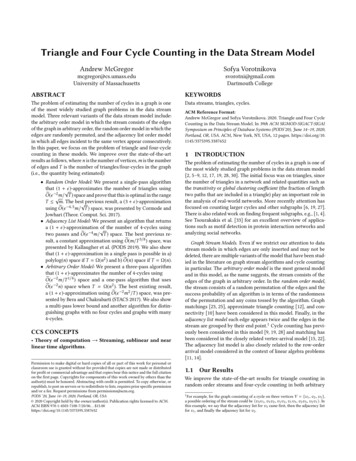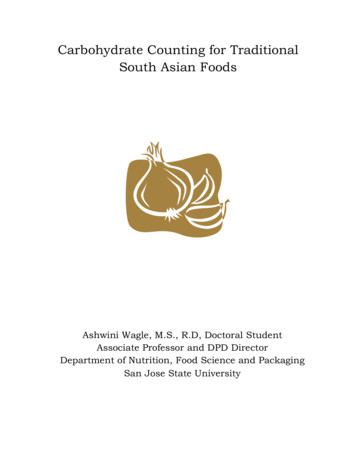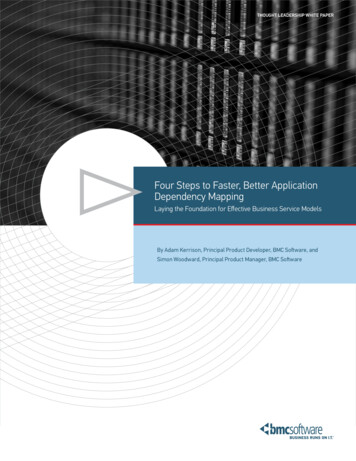
Transcription
Triangle and Four Cycle Counting in the Data Stream ModelAndrew McGregorSofya Vorotnikovamcgregor@cs.umass.eduUniversity of Massachusettssvorotni@gmail.comDartmouth CollegeABSTRACTKEYWORDSThe problem of estimating the number of cycles in a graph is oneof the most widely studied graph problems in the data streammodel. Three relevant variants of the data stream model include:the arbitrary order model in which the stream consists of the edgesof the graph in arbitrary order, the random order model in which theedges are randomly permuted, and the adjacency list order modelin which all edges incident to the same vertex appear consecutively.In this paper, we focus on the problem of triangle and four-cyclecounting in these models. We improve over the state-of-the-artresults as follows, where n is the number of vertices, m is the numberof edges and T is the number of triangles/four-cycles in the graph(i.e., the quantity being estimated):Data streams, triangles, cycles. Random Order Model: We present a single-pass algorithmthat (1 ϵ)-approximates the number of triangles usinge 2m/ T ) space and prove that this is optimal in the rangeO(ϵ T m. The best previous result, a (3 ϵ)-approximatione 4.5m/ T ) space, was presented by Cormode andusing O(ϵJowhari (Theor. Comput. Sci. 2017). Adjacency List Model: We present an algorithm that returnsa (1 ϵ)-approximation of the number of 4-cycles usinge 4m/ T ) space. The best previous retwo passes and O(ϵ3/8 ) space, wasesult, a constant approximation using O(m/Tpresented by Kallaugher et al. (PODS 2019). We also showthat (1 ϵ)-approximation in a single pass is possible in a)e space if T Ω(n).polylog(n) space if T Ω(n 2 ) and b) O(n) Arbitrary Order Model: We present a three-pass algorithmthat (1 ϵ)-approximates the number of 4-cycles usinge 2m/T 1/4 ) space and a one-pass algorithm that usesO(ϵe 2n) space when T Ω(n 2 ). The best existing result,O(ϵe 2m 2 /T ) space, was prea (1 ϵ)-approximation using O(ϵsented by Bera and Chakrabarti (STACS 2017). We also showa multi-pass lower bound and another algorithm for distinguishing graphs with no four cycles and graphs with many4-cycles.CCS CONCEPTS Theory of computation Streaming, sublinear and nearlinear time algorithms.Permission to make digital or hard copies of all or part of this work for personal orclassroom use is granted without fee provided that copies are not made or distributedfor profit or commercial advantage and that copies bear this notice and the full citationon the first page. Copyrights for components of this work owned by others than theauthor(s) must be honored. Abstracting with credit is permitted. To copy otherwise, orrepublish, to post on servers or to redistribute to lists, requires prior specific permissionand/or a fee. Request permissions from permissions@acm.org.PODS ’20, June 14–19, 2020, Portland, OR, USA 2020 Copyright held by the owner/author(s). Publication rights licensed to ACM.ACM ISBN 978-1-4503-7108-7/20/06. . . 15.00https://doi.org/10.1145/3375395.3387652ACM Reference Format:Andrew McGregor and Sofya Vorotnikova. 2020. Triangle and Four CycleCounting in the Data Stream Model. In 39th ACM SIGMOD-SIGACT-SIGAISymposium on Principles of Database Systems (PODS’20), June 14–19, 2020,Portland, OR, USA. ACM, New York, NY, USA, 12 pages. ONThe problem of estimating the number of cycles in a graph is one ofthe most widely studied graph problems in the data stream model[2, 5–9, 12, 17, 19, 28, 30]. The initial focus was on triangles, sincethe number of triangles in a network and related quantities such asthe transitivity or global clustering coefficient (the fraction of lengthtwo paths that are included in a triangle) play an important role inthe analysis of real-world networks. More recently attention hasfocused on counting larger cycles and other subgraphs [6, 19, 27].There is also related work on finding frequent subgraphs, e.g., [1, 4].See Tsourakakis et al. [33] for an excellent overview of applications such as motif detection in protein interaction networks andanalyzing social networks.Graph Stream Models. Even if we restrict our attention to datastream models in which edges are only inserted and may not bedeleted, there are multiple variants of the model that have been studied in the literature on graph stream algorithms and cycle countingin particular. The arbitrary order model is the most general modeland in this model, as the name suggests, the stream consists of theedges of the graph in arbitrary order. In the random order model,the stream consists of a random permutation of the edges and thesuccess probability of an algorithm is in terms of the randomnessof the permutation and any coins tossed by the algorithm. Graphmatchings [23, 25], approximate triangle counting [12], and connectivity [10] have been considered in this model. Finally, in theadjacency list model each edge appears twice and the edges in thestream are grouped by their end point.1 Cycle counting has previously been considered in this model [9, 19, 28] and matching hasbeen considered in the closely related vertex-arrival model [15, 22].The adjacency list model is also closely related to the row-orderarrival model considered in the context of linear algebra problems[11, 14].1.1Our ResultsWe improve the state-of-the-art results for triangle counting inrandom order streams and four-cycle counting in both arbitraryexample, for the graph consisting of a cycle on three vertices V {v 1 , v 2 , v 3 },a possible ordering of the stream could be ⟨v 3v 1 , v 3v 2 , v 1v 2 , v 1v 3 , v 2v 3 , v 2v 1 ⟩ . Inthis example, we say that the adjacency list for v 3 came first, then the adjacency listfor v 1 , and finally the adjacency list for v 2 .1 For
order streams and adjacency list streams. All of our approximationalgorithms yield a (1 ϵ)-approximation for arbitrary 0 ϵ 1/100.In what follows, n and m are the number of vertices/edges in theinput graph and T is either the number of triangles or the number offour-cycles, i.e., the quantity being estimated. We parameterize ouralgorithms in terms of T and various quantities in the algorithmswill depend on it. Obviously, we do not know T in advance, but thisconvention is widely adopted in the literature. A natural way toformalize this is to phrase the problem as distinguishing betweengraphs with at most t triangles/four-cycles and those with at least(1 ϵ)t, where t is an input parameter. In practice, the quantitiesin the algorithms would be initialized based on a lower or upperbound (as appropriate) for T .1.1.1 Random Order Model. We present a single pass algorithmthat (1 ϵ)-approximates the number of triangles T using e 2m/ T )O(ϵ space and prove that this is optimal in the range T m. The beste 4.5m/ T ) space,previous result, a (3 ϵ)-approximation using O(ϵwas presented by Cormode and Jowhari [13].The main idea in the upper bound is a new method for identifying edges that participate in many triangles; this turns out to becrucial to break the factor 3 approximation barrier. The main idea inthe lower bound is a reduction from a communication complexityproblem in the “random partition setting" where the input is randomly partitioned between the players, in contrast to the standardsetting where a worst case partition is assumed. We present therandom order model results in Section 2.1.1.2 Adjacency List Model. We present a two-pass algorithm thate 4m/T 1/2 )(1 ϵ)-approximates the number of 4-cycles using O(ϵspace. This best previous result, a constant approximation using3/8 ) space, was presented by Kallaugher etetwo passes and O(m/Tal. [19]; our result achieves a better approximation in less space. Themain idea is to group 4-cycles into what we call “diamonds" wherethe (u, v)-diamond is a complete bipartite graph between {u, v} and Γ(u) Γ(v); such a graph corresponds to Γ(u) Γ(v)4-cycles. By2estimating the diamonds of different sizes rather than individualfour cycles, we are able to reduce the variance of the estimationprocess and this results in a more space efficient algorithm.We also show that (1 ϵ)-approximation in a single pass ise space ifpossible in a) polylog(n) space if T Ω(n 2 ) and b) O(n)T Ω(n). The main idea for both of these algorithms is to observethat Γ(u) Γ(v) Γ(u) Γ(v) 2 22and to exploit connections to frequency moment estimation and ℓ2sampling. We present the adjacency order model results in Section 4.1.1.3 Arbitrary Order Model. We present a three-pass algorithme 2m/T 1/4 )that (1 ϵ)-approximates the number of 4-cycles using O(ϵspace. This is the first 4-cycle counting algorithm in the arbitraryorder model that achieves sublinear (in m) space for any T ω(1).e 2n) spaceWe also describe a one-pass algorithm that uses O(ϵ2when T Ω(n ). Estimating the number of 4-cycles in the arbitraryorder model is significantly more challenging than estimating thenumber of triangles because of locality issues. Specifically, it isrelatively easy to determine whether an edge (u, v) exists in manytriangles: we sample a set of nodes and compute the fraction thatwould form a triangle with (u, v). For 4-cycles, things get morecomplicated since there are two other nodes in the 4-cycle. The beste 2m 2 /T ) space andexisting result, a (1 ϵ)-approximation using O(ϵfour passes, was presented by Bera and Chakrabarti [6]; our firstalgorithm uses fewer passes and uses less space when T m 4/3 .We also present a two-pass algorithm for distinguishing graphse 3/2 /T 3/4 )with no 4-cycles and graph with at leastT 4-cycles using O(mspace. The algorithm leverages a result in extremal graph theoryand uses less space than our approximation algorithm when T m.Lastly, we present a Ω(m/ T ) space lower bound for any constantpass algorithm that solves this problem. We present the arbitraryorder results in Section 5.Notation. Throughout this paper V is the vertex set of the inputgraph, E is the set of edges, and n V and m E . A wedge is alength two path.2TRIANGLES IN RANDOM ORDER MODELOur main algorithmic result for counting triangles in the randomorder model is:Theorem 2.1. There exists an algorithm which takes one pass overe 2m/ T ) space, and returns aa randomly ordered stream, uses O(ϵ(1 ϵ)-approximation of the number of triangles in the graph withprobability at least 99/100. We then show that the above result is optimal when 1 T m.2.1 eOne Pass Algorithm using O(m/T ) space2.1.1 Basic Idea. One of the main ideas implicit in previous work[13, 28] is that, assuming no edge is involved in too many triangles,the numberof triangles can be approximated by sampling roughly O(m/ T ) edges of the graph and counting the number of trianglesthat include two edges from the sampled set. The threshold for“too many" is roughly T and such edges are referred to as being“heavy" in the literature; we will also use this term but defer anexact definition until the next section. A natural approach is to a)use the above idea to count triangles without heavy edges and b)recognize heavy edges and account for triangles involving theseedges separately. It is possible to do this in two passes [13, 28] ifthe stream is ordered arbitrarily. The main technical breakthroughof our new algorithm is a novel way to identify potential heavyedges as they arrive in the stream, assuming the stream is randomlyordered.2.1.2 Algorithm. It will be helpful to define the following notation:For an edge e and a set of edges F , let teF be the number of trianglesin {e} F that include e. Let te : teE . During a single pass, thealgorithm a) stores a set of edges that will include most edgesinvolved in many triangles and b) collects all edges in triangles thatinclude two edges in a prefix of the stream. Finding Potentially Heavy Edges: For i 0, 1, . . . , log T ,let Vi be a subset of vertices where each vertex is sampled with probability pi : min{1, 10cϵ 2 (log n)/2i } wherec 0 is a constant that will determine the success probability. To implement the algorithm efficiently, we define
Vi as Vi {v : fi (v) 1} using a random hash functionfi : V {0, 1} with the appropriate degree of independenceand where, for all v V , P [fi (v) 1] pi . Let Ei be defined as the set of edges incident to Vi amongstthe first qi m elements of the stream, where qi : 2i / T . During a passover the stream, store the following set of edges:P : {e E : position of e in stream is qi m and teEi 1}We will later show that edges involved in many triangles arevery likely to be included in P. Rough Estimator: Let S be the first rm elements of thestream where r cϵ 1 / T . During a pass over the stream,store the following set of edges:C : {e E : teS 1} .We will later show that S and C are sufficient to estimate thenumber of “light" triangles in the graph, i.e., triangles thatdo not include any edges that occur in many triangles. Post-Processing: Let O E log( T ) and p plog( T ) .(Loracle(e) H if teO p TotherwiseThe oracle will henceforth be used to define whether anedge is heavy or light. That is, while we will later show thate being defined as heavy/light will roughly correspond towhether te is larger/smaller than T , the actual definition is afunction of the edges sampled by the algorithm; this will helpsignificantly with the analysis. Note that the oracle is definedindependently of the ordering of the data stream becauseE log( T ) is constructed based on the entire stream rather thana strict prefix. Let S L, C L, P H be the subsets of the respectivesets restricted to heavy or light edges as appropriate. Return 1 Õ SL 1 Õ OOOt t/2 t/3t ee,0e,1e,2p3r 2HLe Ce POwhere te,iis the number of triangles including e where i ofOthe other two edges in O in heavy. The coefficients of te,itake into account that a triangle with multiple heavy edgescan be counted from the perspective of multiple edges andhence we need to compensate for overcounting.2.1.3 Accuracy Analysis. To prove that the algorithm returns a1 ϵ approximation we will argue that a) the oracle distinguishesbetween edges e with large or small te values with sufficient accuracy, b) the algorithm stores almost all edges with large te values,and c) the number of triangles made of edges with small te values,can be accurately estimated given the “rough estimator." We thenprove a space bound for the algorithm.Note that the number edges that are designated as heavyis at most 4 T since if e is heavy then te p T /(p(1 ϵ)) T /(1 ϵ)and summing te over all heavy edges in at most 3T .Finding Potentially Heavy Edges. We now argue that P, the setof potentially heavy edges we construct, will contain most of theedges that ultimately will be defined to be heavy by the oracle.In particular, let i ⌈log2 T /(cϵ 2te )⌉ and note that if e does notappear within the first qi m edges of the stream then the probabilitye is not added to P is at most 2i(1 qi2pi )te e te 10cϵ (log n)2 /T 1/n 10because the events that different triangles are formed between eand edges in Ei are negatively associated. Therefore, the probabilitythat we do not include heavy edge e in P is P e EH \ P 1/n10 P [e appears in a prefix of length qi m] 1/n10 2i / T 2 T 2 · 2 ,cϵ tewhere we used the fact that 1/n10 was dominated by the secondterm for sufficiently large n.The following lemma establishes that P includes most of theheavy edges in terms of their contribution to the sum of their tevalues.ÍLemma 2.3 (Missing heavy edges). e E H \P te ϵT with probability at least 1 1/c.Proof.p Õ Õ 4 T 16 T H 4 T E te ·t E · 2e 2t 2cϵcϵcϵe e E H \P e E H using the fact E H 4 T (see discussion following Lemma 2.2).The result then follows by an application of the Markov boundassuming ϵ 1/16. Accuracy. The total number of triangles can be written as:ÕT0 T1 T2 T3 T0 (te,0 te,1 /2 te,2 /3)e:heavywhere Ti is the number of triangles with i heavy edges and te,i isthe number of triangles including e where exactly i of the otheredges are heavy. The next two lemmas consider errors incurredwhen estimating the terms T0 and T1 T2 T3 .Lemma 2.4. With probability at least 1 1/c 2 ,1 Õ SLte T0 ϵT .3r 2Le CProperties of the Oracle. Note that for any edge e, teO Bin(te , p)where p was defined to be plog( T ) . The following lemma thenfollows from the Chernoff bound.Proof. Let X be the number of light wedges (paths of length2) in S that can be completed by another light edge. Note thatÍL2LX e C L teS and E [X ] 3r T0 . Since each edge in S can onlyoccur in at most 2 T triangles, the variance can be calculated as V [X ] 3r 2T0 6T0r 3 T 9r 2T0 9c 2ϵ 2OLemma 2.2 (Oracle Guarantees). With high probability, te (1 ϵ)te p for all heavy edges e and te 2 T for all light edges.Hence, by an application of the Chebyshev bound, P X E [X ] 3ϵr 2T 1/c 2 .
Lemma 2.5. With high probability, 1 Õ OOOte,0 te,1/2 te,2/3 (1 ϵ)(T1 T2 T3 ) .pv3u3 2i / T · 2cϵ 2 /2i 2cϵ 2m/ T · log T .u2m logÕTu12.1.4 Space Analysis. It remains to analyze the space used by thealgorithm. The expected space to store all Ei is at mostv2Therefore, by combining Lemmas 2.3, 2.4, and 2.5 we establishthat the estimator gives a 1 ϵ approximation with probability atleast 1 1/c 1/c 2 1/poly(n) 1 3/c. a) Edges of the graph present in the length m/ T prefixof stream. At this point there is no information which twonodes in U V have the same set of neighbors in W .v1 u3The result follows by summing over the heavy edges.v1u2Proof. By an application of the Chernoff bound, for each heavyedge e, with high probabilityOOOte,0 te,1/2 te,2/3 (1 ϵ)p(te,0 te,1 /2 te,2 /3) .v2u1v3e:heavyi 02The expected size of C S is at most 3r T . Hence, the expected space 2em/ T ) as claimed. Note that it exused by the algorithm is O(ϵceeds this space by a factor 1/δ with probability at most δ using astandard Markov Bound argument.2.2Lower BoundWe now prove the following space lower bound for distinguishingbetween triangle-free graphs from graphs with many triangles.Note that this implies no multiplicative approximation is possiblein less space. Theorem 2.6. Assume 1 T m. Any single-pass algorithmthat distinguishes between 0 and T triangles in a graph presented inrandom order with probability at least 1 1/m 2 requires Ω(m/ T )space.The proof will be via a reduction from communication complexity in the random partition setting [10]. The proof involvesconstructing a graph based on a binary matrix and the index to anentry of this matrix such that the graph has T triangles if this entryis 1 and is triangle-free otherwise. Note that it is relatively easy tofind a construction with this property and this sufficed to proveprevious bounds in the arbitrary order model. The main challengein proving the result here is to ensure that if the edges of the grapharrive in random order, then the identity of the entry of interest isnot revealed too early in the stream.We start by presenting the construction. Given x {0, 1}n n , letS x {(x i,j , ui , v j ) : 1 i, j n} and let E x {(ui , v j ) : x i,j 1} .LetPA1 ,.,An ,B1 ,.,Bn {(ui , w) : w Ai , i [n])} {(v j , w) : w B j , j [n])}Let Pi ,j be the collection of all such sets where Ai B j and allthe sets aside from the B j are disjoint sets ofW {w k : 1 k 2nT }of size T . Note that the graph consisting of edges E x P for anyP Pi ,j has T triangles if x i ,j 1 and is triangle-free otherwise.See Figure 1.b) Edges of the graph in entire of stream. u 2 and v 3 have Tneighbors in common in W . There are T triangles iff edge(u 2, v 3 ) is present in the graph.Figure 1: The Lower Bound Construction for n 3,T 2.The graph is a tri-partite graph on nodes (U , V ,W ) whereU {u 1, u 2, . . . , un }, V {v 1, v 2, . . . , vn }, and the shadednodes correspond to the 2
nectivity [10] have been considered in this model. Finally, in the adjacency list model each edge appears twice and the edges in the stream are grouped by their end point.1 Cycle counting has previ-ously been con











